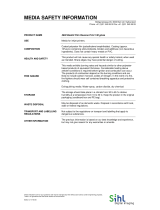
- 3 -
5.
FIRE-FIGHTING MEASURES
FLAMMABLE PROPERTIES
Firefighting procedures:
Remove sources of combustibles. Extinguish the fire
using fire-fighting extinguishing media listed below.
Cool surrounding area (e.g., tanks, buildings) by
spraying water to prevent fire extension.
Extinguished media:
Carbon dioxide, powder or foam.
Fire & explosion hazards:
Dense smoke emitted when burned without sufficient
oxygen.
Firefighting equipment:
Wear positive pressure self-contained breathing
apparatus in any closed space.
6.
ACCIDENTAL RELEASE MEASURES
Remove sources of ignition, wear proper protective equipment when in work. Keep
people away from dangerous area, and evacuate people on the leeward. Wipe up or
scrape up with proper materials, such as cloth, sand, or other absorbents. Dispose of
saturated absorbent or cleaning materials properly. Thoroughly clean the area with
solvents or detergents to avoid slip hazard. Avoid release to the environment.
7.
HANDLING AND STORAGE
Handling:
Remove sources of ignition. This material releases alcoholic gas
during curing. Use with adequate ventilation. Avoid contact with eyes.
Avoid prolonged or repeated contact with skin. Avoid breathing
dust/fume/gas/mist/vapors/spray. Keep away from water and
moisture.
Storage:
Store within a room temperature environment in a cool dry place.
Keep container closed. Keep away from oxidizing materials,
moisture, and water. Store locked up.
8.
EXPOSE CONTROLS / PERSONAL PROTECTION
Eye protection:
Wear protective goggles.
Skin protection:
Wear chemical resistant gloves and work
clothes.








